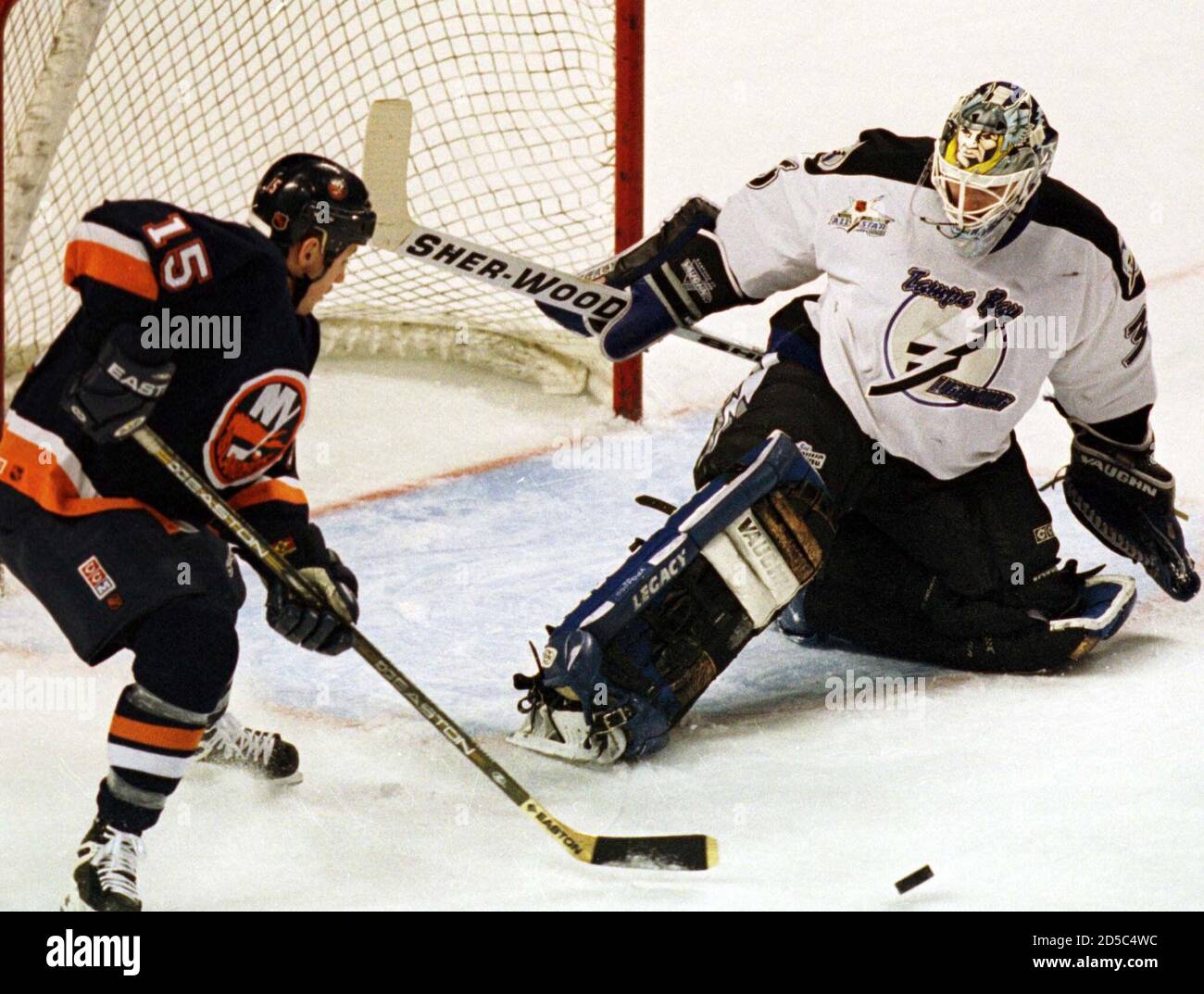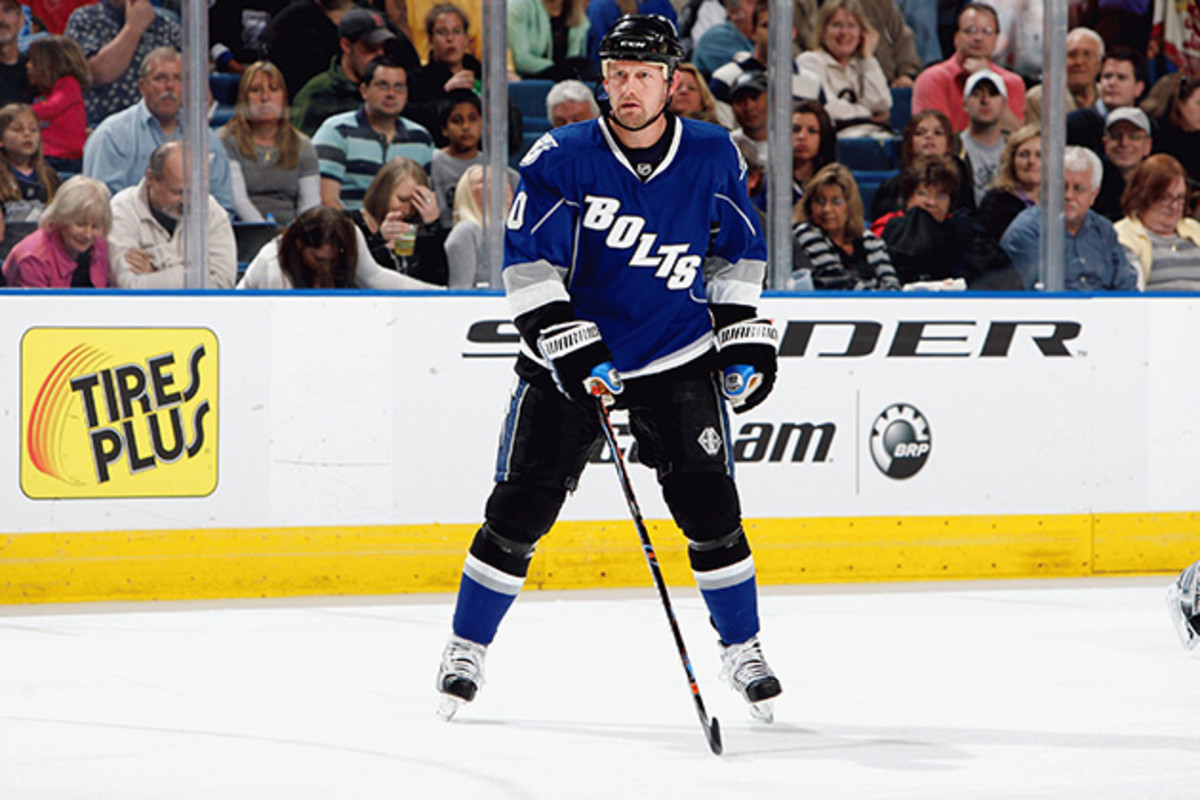After thirty years in the NHL, the Tampa Bay Lightning franchise has seen a lot of terrific players come and go. Some have been franchise mainstays (Lecavalier, St. Louis, Stamkos et al.), while many have been cup-of-coffee-in-the-show types. But not all brief visits have been from fringe players. A variety of great NHLers have suited up in blue and white (or black, blue, silver and white) for brief durations, capping off a long career with a season on Florida's sunny west coast, or been a veteran addition who got flipped late in the season.
While many of these players were long past their prime when they donned the Bolt, they were spectacular at one point of their career or another-- even if their tenure in Tampa Bay may have been forgettable. Here are ten players who played one season (or less) for the Tampa Bay Lightning.
The pride of Kelvington, Saskatchewan, and an NHL all-time great mustache-haver (rockin' a rare goatee in this pic) will always be remembered as the blood-and-guts heart and soul Toronto Maple Leafs captain. And with good reason! Clark put in a dozen seasons in Toronto (plus single season vacations in both Quebec and on Long Island) before signing with the Lightning prior to the 1998-1999 season.
The Lightning's new owner, Art Williamson, had given then-General Manger Phil Esposito the go-ahead to spend some money, hoping to improve a paper-thin roster that finished last in the NHL (by 18 points!) the prior season. Enter Clark, the aging Leaf known for being tough as nails and a hell of a goal scorer. And score he did, sinking 28 pucks in the 65 games he played in TB. He was also the team's All-Star Game representative that year, which the Lightning hosted. Sadly, his goals weren't enough to significantly move the needle for a still-terrible team. They stumbled out of the gate, Esposito was fired before mid-October, and Head Coach and now GM Jacques Demers traded Clark to Detroit before that year's trade deadline.
Along with signing Clark, Esposito also tried to improve the Lightning's forward corps in the summer of '98 by trading bruiser Louie DeBrusk and a draft pick to the Coyotes for silky-smooth center Craig Janney. Once described as having the softest hands in hockey, Janney was a point-per-game player who racked up 185 assists in 186 games centering Brett Hull in St. Louis in the early '90s.
The 1998-1999 Lightning didn't quite have a Hull on their roster, however. As their season spiraled, the team started jettisoning veterans, including Janney. After collecting 22 points in 38 games, he was sent to the Islanders for a sixth-rounder. The Islanders would be his last NHL stop, as blood clots issues forced his retirement at age 32.
Bill Ranford: 1998-1999
One reason the 1997-1998 Lightning team was such a tire fire was their weakness in goal. Franchise goalie Darren Puppa had a bad back and was nearing the end of his run, and the alternatives were... not great. Bill Ranford was a reliable workhorse goalie, best known for his near-decade with the Oilers, including a Conn Smythe Trophy during Edmonton's 1990 Stanley Cup winning playoff run. Esposito sent Washington a 2nd and 3rd round pick for Ranford in the summer of '98, hoping a solid, dependable veteran could help Puppa carry the load.
It was NOT the Conn Smythe version of Ranford that arrived in Tampa Bay for the 1998-99 season. The veteran managed a putrid 3 wins in 26 starts, with a terrible .881 save percentage. The team jettisoned him at the trade deadline, sending him to Detroit.
Sean Burke: 2005-2006
Things were WAAAAAY different for the Lightning in 2005. They were fresh off the 2004 Stanley Cup Championship and ready to defend their title (not counting a one-year break for the labor lockout). Only one problem: All-World goaltender Nikolai Khabibulin decided he was entitled to a super-maximum contract, and departed for the Chicago Blackhawks.
To help fill the 'Bulin Wall-sized hole in the roster, GM Jay Feaster signed Sean Burke to back up Khabibulin's former back up, John Graham. Burke, 39, already had a stellar career, including long stretches as starter in New Jersey, Hartford, and Phoenix, plus being the starting goalie for Canada in the 1992 Olympics. Burke was solid in Tampa Bay, going 14-10-4, with 2 shutouts. He signed with Los Angeles the next season, which would be his last as an active player.
Gary Roberts: 2008-2009
By 2008, the '04 championship glory was gone and the Lightning's wheels had completely fallen off. The team was now owned by a couple of jerks with no idea what they were doing. "OK" Hockey recklessly signed players and traded away others, while barely having the funds to pay the team's bills. They brought in several admired veterans during their delusional spending spree, including Gary Roberts, a Stanley Cup Champion in Calgary in 1989, who had just gone to the 2008 Cup Final with the Penguins.
Roberts was a former fifty goal scorer and a consummate pro, but he was 42 years old. He played 30 games with the Lightning, collecting seven points, before suffering an elbow injury that would end his career. He then transitioned into a new role as a personal trainer, helping a young Steven Stamkos and many others reach their physical potential.
Mark Recchi: 2008-2009
Another 2008 signing by the two idiots who thought they were trading hockey cards, Mark Recchi was a veteran winger with an outstanding hockey career, piling up points during stops around the NHL. He already had two Cup wins and seven All-Star Game appearances by the time he signed a one-year deal with the Lightning, and he continued to score with the Bolt on his chest. He put up 45 points in 62 games before the struggling Lightning shipped him away at the trade deadline.
Recchi kept scoring for a few more years, too; he capped his career at age 43 by winning a third Cup with Boston in 2011, after beating the Lightning in the Eastern Conference Final.
Olaf Kolzig: 2008-2009
Olaf made his first appearance for the Washington Capitals waaaaay back in the 1989-1990 season, and he never played anywhere else... until two jackasses bought the Lightning and thought it would be cool to have him wrap up his career in Tampa Bay.
Kolzig absolutely owns the Washington record book for goaltenders, and having him finish his career with an eight-game, injury-shortened season with the Bolts is just... weird. And he didn't really finish with Tampa Bay either. The owners were secretly hurting for cash, and once he was hurt they packaged his contract with a few on-the-bubble players and a sweetener draft pick and sent them to Toronto as a salary dump.
Simon Gagné: 2010-2011







/cdn.vox-cdn.com/uploads/chorus_image/image/52515713/GettyImages-83008942.0.jpeg)


/cdn.vox-cdn.com/uploads/chorus_image/image/60153217/usa_today_10814679.0.jpg)



.jpg)